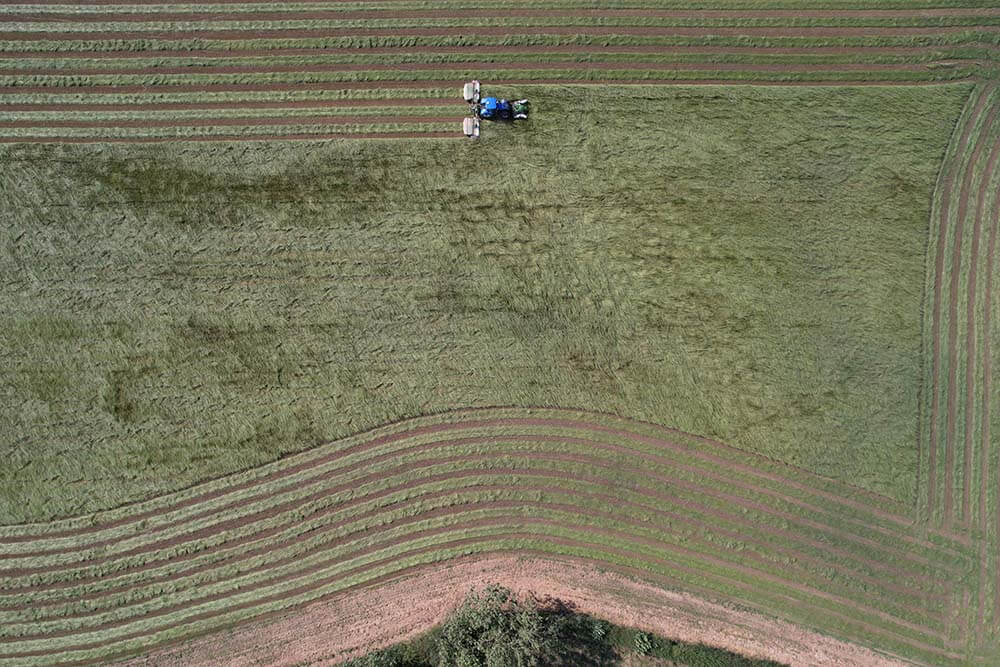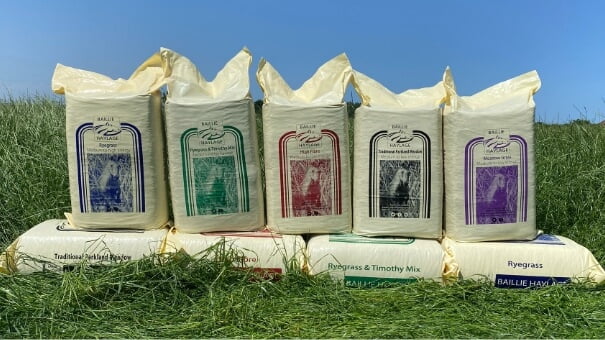‘What’s the difference between haylage and hay?’ is one of the biggest questions we get asked here at Baillie Haylage. And when you’re choosing the right diet for the needs of your horse, it’s an important question to know the answer to.
- What are the differences between Hay and Haylage?
- The nutritional differences between Hay and Haylage
- The Benefits of Haylage
- Choosing the right Haylage for your Horse
What are the differences between Hay and Haylage?
Many horse owners know that put simply, hay and haylage are two types of preserved forage. The difference between the two lies in how the grass is preserved, and the different nutritional value and moisture content of both.
The first difference between haylage and hay is how they’re made. Haylage is grass that has been cut earlier than hay: it’s at a younger stage of growth when it’s cut, and it’s left to wilt instead of completely drying out.
Haylage is preserved using fermentation, and is baled and wrapped in several layers of plastic so it’s moisture content remains high. This is done to stop oxygen from reaching it, preventing harmful mould and spores from growing inside.
Alternatively, hay is conserved using dehydration. It requires a prolonged period of sunny days to completely dry out - which is no easy feat in UK weather! It’s not easy to achieve the usual 88% dehydration that hay requires, and it’s preserved by keeping completely dry.

The nutritional differences between Hay and Haylage
There are significant nutritional differences between haylage and hay that you need to consider when choosing a type of forage.
Hay is cut between June and August, when the grass is at a more mature stage of growth. As such, the moisture content of hay is low (around 86-90% dry matter content, or DM), and some nutrients are lost in the drying process.
As hay contains fewer nutrients and is more mature, it’s a lower calorie forage - making it a brilliant choice for horses in light work or at maintenance.
However, horses with higher energy requirements will need to supplement hay with extra feed. It’s a great option to feed ad-lib to horses, without worrying about your horse gaining weight.
Haylage has a lower DM content than hay, so your horse will need to be fed slightly more weight of haylage than hay to get the desired amount of fibre in their diet - which is important for digestion and general wellbeing.
Haylage is more digestible than hay, giving it a higher digestible energy (or DE) content. Because of this, horses tend to do better on haylage - making it usually less ideal for overweight horses, horses prone to gaining weight, metabolic and laminitic horses.
However, you can get speciality haylage that is high-fibre and low DE to meet those needs.
The Benefits of Haylage
The biggest benefit of haylage over hay for many owners is that haylage is dust free. The moisture in haylage can absorb any potentially harmful spores that horses can inhale, and they stick to the grass - meaning they're eaten instead of breathed in.
It is common for hay to gather dust and mould spores - which is why many horses with allergies, frequently stabled horses or horses with compromised respiratory systems are encouraged to avoid it.
On the other hand, haylage is ideal for horses in regular work, young horses with greater energy and nutritional requirements for growth, and even older horses who need a source of forage that’s easier to digest.
Haylage is considered to be more expensive to buy, however it’s higher digestibility means it requires less additional feed alongside it than hay. It is also possible to manage a horse on a 100% forage diet, if your horse has higher energy requirements and their micronutrient needs are met.
Choosing the right Haylage for your Horse

A popular misconception about haylage is that it’s only suitable for young, energetic horses - however, there is a type suitable for almost every horse.
At Baillie Haylage, we have different types of haylage that are grown from select varieties of grasses and tailored to the specific needs of each horse, including:
- Ryegrass: medium to high energy, Ryegrass is suitable for competition horses and has very good palatability.
- Ryegrass & Timothy: medium energy with improved palatability and a high fibre content. It’s suitable for horses in medium levels of work.
- High Fibre: medium to low energy that’s suitable for horses in light to medium work, good or poor doers and some laminitics.
- Traditional Parkland Meadow: medium to low energy with very good palatability. A mixture of natural grasses grown in historic Lincolnshire parkland. Suitable for horses in light to medium work, picky eaters and some laminitics.
- Meadow Grass: medium to low energy with a soft and leafy texture. It’s suitable for older horses, convalescents, fussy eaters and some laminitics.
To find out more about our products or to place an order with us, give Sarah or Rachel a call on 01472 398696.
